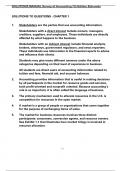Exam (elaborations)
Solutions Manual For Survey of Accounting 7th Edition by Thomas Edmonds, Christopher Edmonds, Philip Olds
- Course
- Institution
Solutions Manual For Survey of Accounting 7th Edition by Thomas Edmonds, Christopher Edmonds, Philip Olds ISBN: 9783 . X Survey of Accounting 7e solutions. Edmonds 7e solutions manual.TOC:= Chapter 1 An Introduction to Accounting Chapter 2 Accounting for Accruals and Deferrals Chapter 3 Accou...
[Show more]



